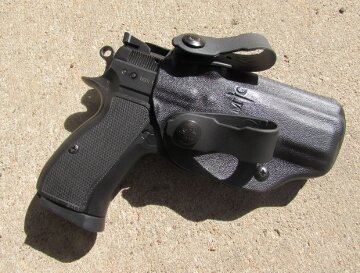Holster Recommendations
Disclaimer: There is a greater potential for injury when drawing and holstering. Do not attempt without proper training.
I am often asked for recommendations on holsters for both concealed carry and range training. I have nervously watched shooters use ‘cheap’ or flimsy holsters which increase the danger of a negligent discharges. For this reason I will not allow a student to train out of an unsafe holster in my classes. Shooters have accidentally shot themselves while drawing or re-holstering. This is not the time to be cheap. Sometimes equipment is a contributing factor, and usually trigger finger discipline (or the neglect of it) is a major factor. I have put together some guidelines to keep in mind when searching for your holster.
Ultimately, your friend’s favorite holster may not work for you. Body type, firearm, and carry location will have a significant impact on this. It is unlikely you will find your perfect fit in one purchase. When possible try some out before buying. Do not neglect the belt, as the foundation, it must be stiff, sturdy, and designed for firearms use. Be sure to match the holster’s belt loop size to your belt size.
Gun Belts
A good gun belt should be purpose built. Even rugged and strong looking belts from outdoor stores may be too flimsy for supporting the weight of a loaded handgun in a holster. They may fail to keep the holster anchored to your body, sag throughout the day, and hinder concealment.
Flex also means the holster will initially move with the gun when the draw is initiated. This will slow the release of the gun. The belt is the foundation of your carry system.
Ironically, a belt named ‘The Foundation Belt’ by EDC Belt Co. is my current everyday carry. It is constructed of Cordura and reinforced nylon. While rigidity is necessary for support, when a stiff belt is worn tightly it may become uncomfortable. The Foundation addresses this with reinforcement where needed and flexibility in the back where it is not. This results in solid draws with more comfort. It is simple, lightweight, and low profile. There is no buckle - It fastens with Velcro.
I have two Mean Gene Leather ‘Victory Aegis’ belts. They look great and are very sturdy. The buckles are first rate and allow infinite adjustment. Gene has many other styles with a variety of buckle options. They provide solid support for inside or outside the waist carry. I have worn mine for about 5 years. When I wear a suit and my buckle shows, I use the Mean Gene, otherwise it is the Foundation for comfort.
Holster Criteria
Model Specific - the holster should be made for your gun (not universal).
Rigid - it should maintain an open shape when the gun is drawn to make holstering safe. Even when worn inside the waistband it should not collapse when the gun is drawn. If it does, holstering becomes more dangerous. Nylon and soft suede are literally the opposite of this.
Enclosed Trigger Guard - This is a must. This protects you from the gun discharging after you safely holster.
Securely Attached - the loops or clips should be strong and properly sized to match the belt.
Retention - I recommend formed / friction fit retention for concealed carry. The gun should not fall out if you run, fall, trip, or do a backflip while dancing. Having said that I do not think extra retention devises are needed for concealment but should be considered for open carry.
Holster Types
There are two broad categories based on how the holster is worn. One is OWB or outside the waist band and the other is IWB or inside the waistband. Either is fine. Inside conceals more of the firearm in the pants with only the grip exposed. Outside can be more comfortable because there is no added bulk inside the pants. With either method, concealment is primarily achieved with a slightly loose ‘cover’ garment or shirt.
Appendix Carry may be thought of as a third category or a placement variation of IWB. It refers to the location of the gun. Holsters intended to be carried appendix should be designed for the position (not an IWB moved up front). Appendix carry has additional muzzle orientation concerns.
Materials
Most holsters are made of leather, plastic (kydex), or a combination of both (hybrid). There are numerous good leather holsters on the market like DeSantis, Bianchi, Safariland, and many more. If they are sturdy and made specifically for your firearm, they are generally good.
Leather is more comfortable against the body while plastic or kydex often provides an easier draw with less friction and easier re-holster. I carry kydex every day. The hybrid is typically found in the IWB design. There leather against the body increases comfort with kydex forming the holster. I have also used these for many years.
Unsafe Holsters
Soft holsters typically made of nylon or suede collapse during holstering. The material can bunch up and become folded inside the trigger guard, pressing the trigger. This can cause the firearm to discharge and it is inevitably pointing at the body at this moment.
I discourage the use of the Blackhawk Serpa holster. While it attempts to incorporate straight trigger finger discipline in the design, it requires inward pressure from the trigger finger on the release. In my opinion this could contribute to pressing toward the trigger as the gun clears the holster when the orientation rotates from down to forward. This may contribute to premature trigger placement.





